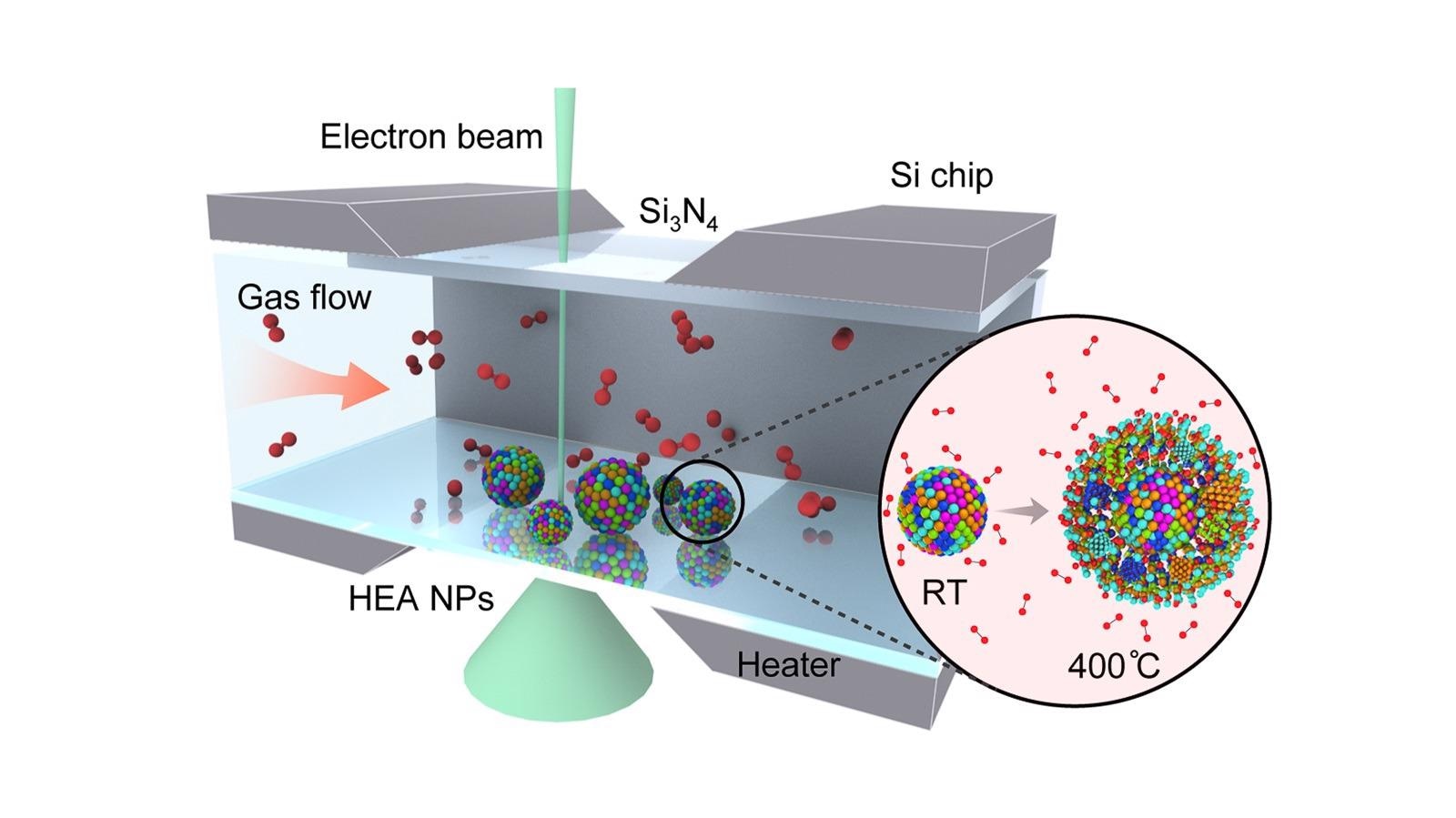Jan 5 2021
Catalysts form part of numerous aspects of modern society. They accelerate crucial chemical reactions, supporting industrial manufacturing, and minimizing hazardous emissions.
 Schematic of the setup used to study the oxidation of high-entropy alloy nanoparticles (HEA NP). Inset shows HEA NP structure at room temperature (RT) and during the high-temperature oxidation. Image Credit: University of Illinois Chicago.
Schematic of the setup used to study the oxidation of high-entropy alloy nanoparticles (HEA NP). Inset shows HEA NP structure at room temperature (RT) and during the high-temperature oxidation. Image Credit: University of Illinois Chicago.
They enhance the efficiency of chemical processes for applications varying from transportation and batteries to laundry detergent and beer.
Although catalysts are crucial for various processes, how they work has mostly been mysterious to researchers. Insights into catalytic processes could enable researchers to create more efficient, economical catalysts.
As part of a new study, researchers at the University of Illinois Chicago (UIC) and the U.S. Department of Energy’s (DOE) Argonne National Laboratory found that, in a chemical reaction that usually degrades catalytic materials rapidly, a specific kind of catalyst exhibits very high durability and stability.
The new catalysts studied are alloy nanoparticles—nanosized particles formed of several metallic elements like copper, nickel, cobalt, and platinum.
These nanoparticles could find numerous practical applications, such as water-splitting for producing hydrogen in fuel cells, carbon dioxide reduction by capturing and transforming it into useful materials such as methanol; highly efficient reactions in biosensors to detect substances in the body, and solar cells that more effectively generate electricity, heat, and fuel.
In the study, the researchers examined “high-entropy” (highly stable) alloy nanoparticles. Led by Reza Shahbazian-Yassar at UIC, they used Argonne’s Center for Nanoscale Materials (CNM), a DOE Office of Science user facility, to determine the compositions of the particles during oxidation—a process by which the material degrades and its usefulness in catalytic reactions reduces.
Using gas flow transmission electron microscopy (TEM) at CNM, we can capture the whole oxidation process in real time and at very high resolution. We found that the high-entropy alloy nanoparticles are able to resist oxidation much better than general metal particles.
Bob Song, Study Lead Scientist, University of Illinois Chicago
The researchers performed the TEM by embedding the nanoparticles into a silicon nitride membrane and made various types of gas to flow through a channel and over the particles. An electron beam was used to investigate the reactions between the gas and the particles, which showed the low rate of oxidation and the migration of specific metals—cobalt, iron, copper, and nickel—to the surfaces of the particles during the process.
Our objective was to understand how fast high-entropy materials react with oxygen and how the chemistry of nanoparticles evolves during such a reaction.
Shahbazian-Yassar, Professor of Mechanical and Industrial Engineering, College of Engineering, University of Illinois Chicago
Shahbazian-Yassar added that the findings of this study could be advantageous to various energy storage and conversion technologies, such as fuel cells, catalyst materials, lithium-air batteries, and supercapacitors. Moreover, the nanoparticles could even be used to create high-temperature and corrosion-resistant materials.
This was a successful showcase of how CNM’s capabilities and services can meet the needs of our collaborators. We have state-of-the-art facilities, and we want to deliver state-of-the-art science as well.
Yuzi Liu, Scientist, Center for Nanoscale Materials, Argonne National Laboratory
The co-authors of the study include Yong Yang from the University of Maryland; Muztob Rabbani, Timothy Yang, and Wissam Saidi from the University of Pittsburgh; Kun He, Xiaobing Hu, and Vinayak Dravid from Northwestern University; Yifei Yuan from UIC; and Pankaj Ghildiyal and Michael Zachariah from the University of California.
This study was partially funded by the National Science Foundation and DOE’s Office of Science.
Video of transmission electron microscopy, performed at Argonne’s CNM, showing the oxidation of high-entropy nanoparticles in air at 400 °C, sped up by a factor of four. The oxidation process is depicted by the dissolution of the edges of the nanoparticles in the video. Video Credit: University of Illinois.
Journal Reference:
Song, B., et al. (2020) In Situ Oxidation Studies of High-Entropy Alloy Nanoparticles. ACS Nano. doi.org/10.1021/acsnano.0c05250.